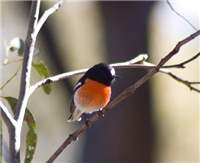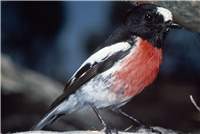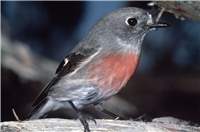Family
Petroicidae
Genus
Petroica
Species
multicolour
Threats/Control Methods - Regional
In the ACT, it is possible that as little as 3-4% of the original extent of the Yellow Box/Red Gum Grassy Woodland remains in something like its natural state. Worse still, the adjoining NSW woodlands only remain at 0.01% of their original extent. This ongoing decline in the Scarlet Robin's habitat, coupled with the fairly recent bushfires and droughts has put a strain on the population. This species is very susceptible to a range threats in this region, especially from land clearing and predation.
Threats/Control Methods - Local
This small bird is at risk of attacks in the suburbs from other more aggressive pet and bird species.
Local/Urban Actions
Gardeners in the Canberra region with more natural, untamed backyard settings are more likely to provide a good environment for foraging and shelter for this species. Potential firewood and other ground cover should be left in local reserves as a foraging resource. Cat owners can prevent their pets preying on the robins by creating a stimulating indoor environment and by installing a cat run or enclosure.
Common Names
Scarlet Robin, Scarlet-breasted Robin, White-capped Robin
Distinguishing Features
This medium sized robin is 12-14cm and has a plump appearance with a small pointed bill. Male birds have a black head, back, wings and tail, with an obvious white patch above their bill and on their wings. Their breast is a bright scarlet red colour and the lower underparts are white. Female birds are much paler, consisting of brown-grey upper parts, a small and pale red breast, black wing feathers and very light grey underparts. Young birds are similar to females, with some white streaks across their head and backs and brown speckles on their underparts.
Survey Techniques
Call and visual identification.
Species Call
A high, whistling song of pleasant trills. Males defend territory with a 'trrut!'.
Similar Species
The Flame Robin (Petroica rodinogaster) is a duller version of the Scarlet species, with an orange-red breast and grey head and back. The Red-capped Robin (Petroica goodenovii) is differenciated by the large crimson patch on its head.
Distribution
This species is found across the most populated eastern areas of Australia, from southern QLD through NSW and VIC to Adelaide, across TAS and in the southwest tip of WA. It is also found across the Pacific Islands of Fiji, Vanuatu and the western Solomon Islands. Locally, the birds are most commonly sighted in the woodlands around the Canberra region.
Country of Origin
Australia
Conservation (Pet/Pest) Status - Regional
The Scarlet Robin appears to be fairly common with a stable population number (COG).
Conservation (Pet/Pest) Status - National
Secure, not listed under the EPBC Act 1999. The population of Norfolk Island (Petroica multicolour multicolour) is considered Vulnerable. The WA population (Petroica multicolour campbelli) is also under threat from extended land clearing.
LSCCES Population
A few Scarlet Robin sightings were recorded on the Acton Peninsula of the ANU campus.
Associated vegetation community
This species survives in a variety of habitats, including open forest, woodland, grassland, farmland, suburban gardens and urban parks.
Limiting Resources
Scarlet Robins depend on an environment that is free from predation from other ground dwelling species such as European Red Foxes (Vulpes vulpes), Dogs (Canis familiaris) and Cats (Felis catus). They rely on thick ground vegetation and leaf litter to forage through for insects and need a large forest territory to return to every year for breeding.
Breeding
The breeding season runs from July to January. A breeding pair mate for life and will defend the same breeding territory year after year. The female builds an open cup nest from grass, twigs and leaves in a sheltered spot on a low tree fork. In the suburbs, human structures like roof gutters or eaves can also be used as nest sites. About 3 eggs are laid and incubated for 16 days by the female. Both parents feed the birds for some weeks after they hatch.
Behaviour
This species is most regularly seen in the Canberra region over the autumn months, moving up into the mountain forests for summer breeding. During the breeding season the male bird shows off and defends his territory by singing loudly from a high and noticeable perch. While in the suburbs, the birds are usually seen singularly or in pairs, seeming fairly comfortable around humans, as they are not easily startled.
Functional Group
Food Species
The Scarlet Robin forages on or near the ground for insects. It will sometimes feed in groups with other insectivores, such as Weebils (Smicrornis brevirostris ) and Grey Fantails (Rhipidura fuliginosa ).
Predators
Predation is a major threat, as the ground feeding robins are prone to attacks from feral and domestic Dogs (Canis familiaris), Cats (Felis catus) and European Red Foxes (Vulpes vulpes).
Interesting Fact
The Scarlet Robin's local woodland habitat was badly impacted in the Canberra bushfires of 2003 and it is not yet known if the population will return to its previous numbers.
References - (reader suitability of references, P=Primary teachers, S=Secondary students, T=Tertiary students and researchers)
Books:
Morcombe, M. 2000. Field Guide to Australian Birds. Steve Parish Publishing. Archerfield. Australia P, S, T
Schodde, R. and Tideman, S. (eds) 1990. Reader's Digest Complete Book of Australian Birds (2nd Edition). Reader's Digest Services Pty Ltd. Sydney. P, S, T
Veerman, P. 2003. Canberra Birds: A report on the first 21 years of the garden bird survey. Philip Veerman and Canberra Ornithologists Group. Canberra. S, T
Internet:
Birds in Backyards. 2006. [online]. Available at:
http://www.birdsinbackyards.net P, S, T
Canberra Ornithological Group (COG). 2004. Birds of Canberra Gardens. COG and the ACT Department of Urban Services. [online]. Available at:
http://garden.canberrabirds.org.au/ P, S, T
Online Publications:
ACT Government. 2004. Woodlands for Wildlife: ACT Lowland Woodland Conservation Strategy. Action Plan No. 27. Environment ACT, Canberra. [online]. Available at: http://www.environment.act.gov.au/nativeplantsandanimals/threatecspec/woodlandsstrategy S, T
Environment ACT. ACT Government. 2006. Action Plan No. 18: Brown Treecreeper. [online]. Available at:
http://www.environment.act.gov.au/__data/assets/pdf_file/13567/actionplans18.pdf S, T
Garnett, S. and Crowley, M. 2000. The Action Plan for Australian Birds 2000. Department of Environment and Water Resources. [online]. Available at: http://www.deh.gov.au/biodiversity/threatened/publications/action/birds2000/index.html S, T
Nix, H. and Cunningham, R. 2006. Birds of the Lower Sullivans Creek Catchment, Canberra ACT. Prepared for the Life in the Suburbs project using data from the Lower Sullivans Creek Catchment Ecological Survey (LSCCES). Australian National University. Canberra. [online]. Available at: http://www.lifeinthesuburbs.com.au/category.php?id=65 S, T



 Top
Top Top
Top